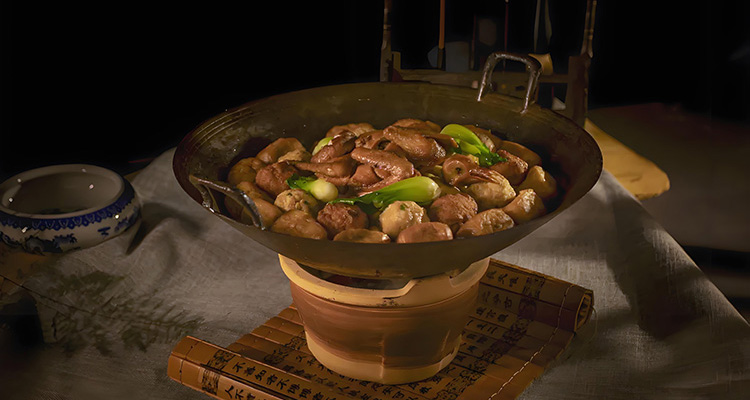Hu Shi One-Pot Hotpot: Huizhou Winter Classic
1. Origin: A honored name from the Shangshu residence
Yipin Guo’s origin is tied to a Ming‑dynasty titled lady. In Shitai County, the official Bi Qiang served as a high-ranking minister, and his wife, Ms. Yu, was clever and capable. Once the emperor unexpectedly visited the Shangshu residence. Beyond lavish delicacies, Ms. Yu served a common Huizhou winter home-style hotpot. The emperor, delighted by its flavor, praised it heartily. When he learned the dish had been prepared by the lady of the house, he exclaimed, “So it is truly a ‘Yipin Guo’!” With that imperial remark, the humble family hotpot gained a distinguished name and entered the Huizhou culinary canon. The story highlights Huizhou women’s household skill and sincere hospitality.
2. Meaning: Hotpot as Huizhou “food ritual”
Yipin Guo is more than a legend; it’s rooted in Huizhou’s unique “food ritual” culture. Traditional Huizhou society valued Confucian order, clan ties, and etiquette, all of which appear in this hotpot. Various ingredients coexist harmoniously in one pot, symbolizing family and clan unity; the layered arrangement reflects order and respect among generations. Historically, this pot was served at festivals or for honored guests: presenting a steaming, grand pot immediately brought hosts and guests closer. The famed scholar Hu Shi, a native of Jixi in Huizhou, favored this hometown dish when entertaining, so many literati began calling it “Hu Shi Yipin Guo,” adding cultural refinement to its reputation. Tasting Yipin Guo is tasting a concentrated serving of Huizhou human warmth and history.

3. Ingredients and technique: Mountain and field flavors in one pot
The charm of Yipin Guo lies in its seemingly simple but deeply considered ingredient combinations and careful cooking.
Ingredients: The dish reflects Huizhou’s “use-local-resources” approach. Typical local ingredients include:
– Hearty meats: pork (often salted or cured pieces) provides a rich base; chicken or duck adds savory depth; sometimes meatballs or stuffed egg dumplings are included.
– Fresh vegetables: the bottom often holds flavor-absorbing dried bamboo shoots and radish; middle layers may include tofu and shiitake mushrooms; leafy greens top the pot. The balance of meat and vegetables yields complete nutrition.
Technique: The essence is layering and simmering. Chefs place hard-to-season items like dried bamboo shoots and radish at the bottom, then layer meats, tofu, and other ingredients in sequence, pour in a prepared stock, and simmer gently for hours. This slow process allows flavors to merge through every layer. Meats become tender and deeply flavored; vegetables soak up the broth’s essence, producing a pot with rich, layered taste and concentrated broth.
4. Flavor and tasting: A symphony on the palate
Tasting Yipin Guo is a gradual exploration of flavors.
Flavor profile: An immediate savory saltiness emerges from cured meat and stock. As you chew, the freshness of chicken or pork unfolds; meats are stewed to softness that almost melts in the mouth. The bottom-layer dried bamboo shoots and radish, having absorbed the meaty essence, become exceptionally flavorful and help cut richness. The overall mouthfeel is tender and comforting; the broth is concentrated and full-bodied but not greasy — suitable for all ages. In cold winter, a few bites warm stomach and heart alike.
How to enjoy: Traditionally people sit around the pot with a low heat to keep it simmering. Diners pick preferred items directly from the pot, eating as it cooks; later the broth grows even more concentrated and flavorful. Begin by sipping the clear broth to appreciate its depth, then taste the various ingredients to experience the texture layers. A bowl of white rice pairs perfectly — pour the rich broth over rice for an especially satisfying bite.

5. Traveler tips: Where and when to try authentic Yipin Guo
If you visit Huizhou and want to try this traditional dish, here are practical tips:
– Where to taste: The most authentic experience is in Huizhou’s ancient villages (for example, Shexian, Yixian, Jixi) at local eateries or guesthouses. Many restaurants list it as a signature dish, but booking ahead is recommended because preparation takes time.
– Best season: Autumn and winter are ideal for enjoying Yipin Guo. Cold weather and a steaming pot make for the most pleasant experience.
– Ordering notes: Portions are usually large and meant for sharing (typically 2–4 people per pot). Ask the host about the exact ingredients when ordering.
– Cultural add-on: If you have time, visit sites related to the dish’s cultural background (for example, Hu Shi’s former residence) to deepen your culinary experience.
6. Try it at home: A simple Huizhou-style recipe
You can attempt a simplified home version to recreate some of Huizhou’s flavors.
Ingredients: pork belly chunks, chicken pieces, salted or cured pork slices, fried meatballs, rehydrated shiitake mushrooms, dried bamboo shoots (or fresh bamboo), radish, tofu puffs, leafy greens.
Simple steps:
1. Rehydrate and cut dried bamboo shoots; cut radish into chunks and blanch.
2. Lay radish and bamboo shoots in a clay pot or deep pot.
3. Layer pork belly, chicken, salted pork slices, shiitake, and tofu puffs.
4. Add ginger slices and scallion sections; pour in enough stock (or water with concentrated stock) to cover ingredients; add a splash of cooking wine and a little soy sauce for seasoning.
5. Bring to a boil, then simmer on low for 1–1.5 hours until everything is tender.
6. Add leafy greens in the last ten minutes to blanch.
While a home version cannot fully replicate the traditional methods, it can convey much of the dish’s comforting flavor.
A steaming pot of Hu Shi One-Pot Hotpot carries the warmth of history and the depth of human connection — lift the lid, taste Huizhou’s mountain-and-field flavors, and go experience this time-traveling culinary delight in Huizhou for yourself. Prepare your palate and try it in Huizhou today!


